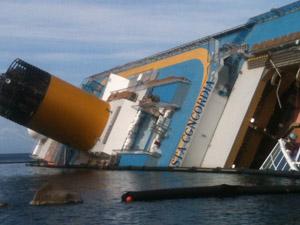Removal of Capsized Costa Concordia to Begin in Italy
Costa Concordia wreck (Photo: Megan Williams)
This month, an American company plans to start a long and difficult salvage project along the coast of Italy.
The project is the removal of the capsized cruise ship “Costa Concordia.” It ran aground on Giglio island, off the coast of Tuscany, in January. 32 passengers were killed.
Italian authorities are still investigating the accident and the ship’s captain, who is accused of causing it. Now island residents can’t wait for the massive hulk to be gone.
“On these hills, (there is) honey that is produced, because you can see there are lots of flowers,” said a local tour guide to a goup of journalists recently, as their minivan climbed the main road on the island.
The tour is part of a plan to promote all the positives Giglio has to offer, and to counteract what most of the world now associates with the small Mediterranean island.
Mayor Sergio Ortelli says there’s a need to counteract global press coverage of the Costa Concordia disaster. He wants people to associate his island with tourism, not death.
Tourist bookings on Giglio are way down this year, though the mayor concedes it’s tough to tell whether that’s a result of the economic recession in Italy or the wreck.
So it’s good news for residents that the American company Titan Salvage will team with Italian contractor Micoperi to tow away the ship in one piece. The two companies will work together to tug the 114,000-ton ship upright onto an underwater platform, where they’ll repair the gash on its side.
They’ll then attach two air-filled flotation devices to keep the vessel buoyant as it’s towed to a nearby port. The year-long, $300 million removal project is set to start this month.
Mayor Ortilli says the plans respects the community’s wishes. “It respects the environment,” says Ortilli. “It won’t interfere with tourism, and it will keep the ship whole, so any contaminated liquids will not be spilled.”
Those liquids include paint, cleaners and cooking oil normally used on the cruise ship. They’re still held in plastic and metal containers aboard the ship.
Marcello Mossa Verre, the head of Tuscany’s Environmental Protection Agency, is worried that those containers which could begin to degrade in the corrosive sea water.
“If they can remove the ship quickly, and by quickly, I mean months or a year at the most,” says Mossa Verre, “then the containers can hold. But they can’t hold indefinitely. We’ve analyzed the plastics and know that if the ship stays there longer, it will be a problem.”
A problem both for the sea around the ship, which teems with dolphins, fish and coral life, and for the local inhabitants, who want to put the Costa Concordia tragedy behind them so their island can once again be associated with pleasure, not tragedy.
